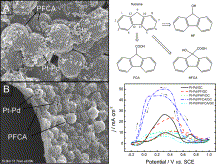Electrocatalytic oxidation of formic acid on Pt–Pd decorated polyfluorenes with hydroxyl and carboxyl substitution
Ruirui Yuea, b, Caiqin Wanga, Fengxing Jianga, Huiwen Wanga, Yukou Dua (杜玉扣), Jingkun Xub, (徐景坤)Ping Yanga
a College of Chemistry, Chemical Engineering and Materials Science, Soochow University, Suzhou 215123, PR China
b Jiangxi Key Laboratory of Organic Chemistry, Jiangxi Science and Technology Normal University, Nanchang 330013, PR China
Int. J. Hydrogen Energy 2013, 38, 12755–12766
A series of novel Pt–Pd/polyfluorenes (PFs) composite catalysts were facilely prepared based on Pt/Pd precursor and PFs with hydroxyl and carboxyl substitution at the C-9 position by electrochemical method and their electrocatalytic performance toward formic acid oxidation were studied. Electrocatalytic experiments demonstrate that the Pt–Pd nanoparticles immobilized on poly(9-fluorenecarboxylic acid) (PFCA)-decorated glassy carbon (GC) electrode (Pt–Pd/PFCA/GC) show larger electrochemical active surface area, higher catalytic activity and stability toward formic acid oxidation than that of other Pt–Pd/PFs/GC, Pt–Pd/GC, as well as the commercial JM 20% Pt/C/GC electrodes, which can be attributed to the small-sized and well-dispersed Pt–Pd nanoparticles on PFCA matrix and the special electronic interaction between the metal nanoparticles and the polymer substrate. Moreover, the electron-withdrawing carboxyl substitution rather than the electron-donating hydroxyl on the polymer main chain is of great benefit to the removal of poison CO as well as the enhancement of catalytic activity of Pt–Pd toward formic acid oxidation.

链接: //www.sciencedirect.com/science/article/pii/S0360319913018211